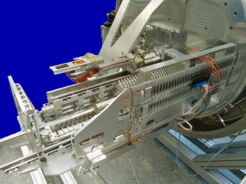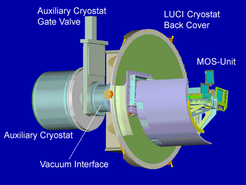LUCI MOS-Unit

The LUCI MOS-unit is a highly complex subsystem of LUCI which performs the following tasks:
- storage of 10 single slit and field limiting masks and of 23 multi-slit masks in LUCI,
- positioning and locking of any of these masks in the telescope focal plane with an accuracy of 0.01 mm,
- mask exchange between the storage cabinets and the focal plane,
- exchange of the cabinet holding the multi-slit masks with the LUCI cryostat at operating temperature (about 80 K).
The MOS-unit disaggregates into the mask exchange unit located inside the LUCI cryostat, and two auxiliary cryostats together with their handling and alignment tools, required for cabinet exchange.
The Mask Exchange Unit

The mask exchange unit is located inside the LUCI cryostat and therefore is operated at a temperature of about 80 K. Since the cryostat rotates about its optical axis, the unit has to function at arbitrary orientations. The mask exchange unit comprises the following components (Fig.1 and Fig.2):
- The focal plane interface positions and locks a mask in the telescope focal plane with an accuracy of 0.01 mm.
- The stationary and the exchangeable mask storage cabinet accept the masks in their frames.
- The mask sheets are mounted in frames providing interfaces to other components and defining the cylindrical shape of the masks (the image surface has a radius of curvature of 1030 mm).
- The robot grabs a mask with its two fingers, removes it from the cabinet by rotation, carries it to the focal plane unit by linear travel, and positions the mask by rotation above the centering pins of the unit. The frame is lowered on the centering pins by another linear travel of the robot. Two stepper motors move the fingers of the robot and rotate the "head" on which the fingers are mounted.
- The translation drive of the robot comprises a set of two rails and a motor driven ballscrew. The robot is attached to the nut of this screw, which drives the robot over a distance of 45 cm parallel to the mask cabinets. The drive also provides a locking mechanism for the ballscrew and thus the position of the robot.
- The mask retainer locks the masks in the cabinets and only releases the mask which the robot carries to the focal plane unit. Only for mask cabinet exchange all masks are released simultaneously.
- The cabinet drive includes a rail system similar to the one in the robot translation drive, but with a wider wheel track, and a screw with 23 mm pitch to move the cabinet during cabinet exchange. Also integrated is a motor driven locking mechanism for the exchangeable cabinet.
- The cold shutter covers the breakout in the LUCI radiation shield through which the cabinet is transferred between the cryostats. The breakout is normally closed to reduce the heat load from warm radiation, and is opened only for cabinet exchange.
- All components mentioned so far, with the exception of the focal plane unit, are integrated into the MOS-structure, a space truss which also provides the connections to the LUCI structure.
For detailed images of these components see the LUCI image gallery.
Mask Cabinet Exchange

Mask cabinet exchange is a more complex procedure than mask exchange, because three independant system, LUCI and two auxiliary cryostats are involved. Inside both auxiliary cryostats drive units are installed, which are identical to the cabinet drive in LUCI. In addition, the auxiliary cryostats are equipped with switchable thermal bridges to cool the mask frames. For mask cabinet transfer, the auxiliary cryostat has to be positioned relative to LUCI so that the rails in both cryostats are aligned to better than 0.5 mm.
Mask cabinet exchange starts by connecting the empty auxiliary cryostat to LUCI and pumping the volume between the cryostats. After opening the auxiliary cryostat gate valve and then the LUCI gate valve, the cold shutter opens the breakpout in the LUCI radiation shield. Now the cabinet with the used masks is driven from LUCI into the auxiliary cryostat. During this procedure, the cabinet is first driven by the screw in LUCI, then, for one turn, by both screws, and finally by the screw in the auxiliary cryostat only. This operation implies that the screws are synchronized such that a fixed relation between their azimuth angles is preserved which makes both screws part of a longer, single screw.
When the cabinet has been moved into the first auxiliary cryostat, the cold shutter and the gate valves are closed, the volume between the cryostats is vented, and the cryostats are disconnected from each other. Then the second auxiliary cryostat holding the pre-cooled, newly made, masks is attached to LUCI, and by applying the procedure just described, the cabinet is transferred from the auxiliary cryostat to LUCI.


